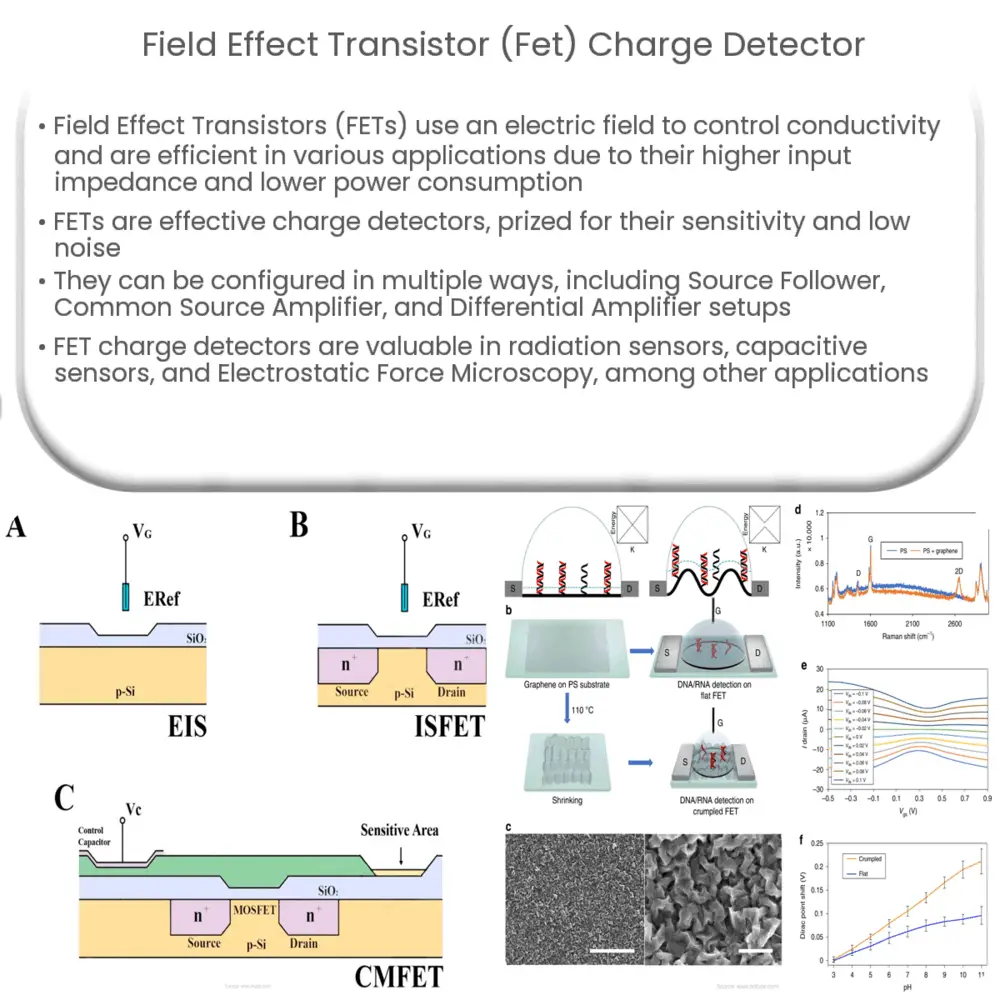FET charge detectors are highly sensitive devices that measure small charges in applications like radiation sensing, capacitive sensing, and electrostatic force microscopy.

Field Effect Transistor (FET) Charge Detector: An Introduction
Understanding Field Effect Transistors (FETs)
Field Effect Transistors (FETs) are a class of semiconductor devices that employ an electric field to control the conductivity of a channel in the device. FETs have three terminals: the source, drain, and gate. The voltage applied to the gate terminal modulates the current flow between the source and drain terminals. Compared to bipolar junction transistors (BJTs), FETs exhibit higher input impedance, lower power consumption, and faster switching speeds, making them ideal for use in a wide range of applications, including integrated circuits, amplifiers, and oscillators.
Charge Detection with FETs
Charge detection is an important aspect of numerous applications, including radiation sensing, capacitive sensing, and electrostatic force microscopy. In these contexts, FETs can be utilized as charge detectors due to their high sensitivity and low noise characteristics. When a charge is applied to the gate terminal of a FET, it modulates the current flowing between the source and drain, effectively converting the charge into a measurable electrical signal. The ability of a FET to detect and amplify small charge signals makes it an attractive option for charge detection applications.
FET-based Charge Detector Configurations
There are several configurations in which FETs can be utilized for charge detection. Some of the most common ones include:
1. Source Follower Configuration
In this configuration, the FET is connected in a source follower (also known as a common drain) arrangement. The charge to be detected is applied to the gate terminal, and the output signal is taken from the source terminal. This configuration offers a high input impedance, allowing for the detection of small charges with minimal loading effects. Additionally, the source follower provides a low output impedance, facilitating easy interfacing with other devices.
2. Common Source Amplifier Configuration
The common source amplifier configuration is another popular arrangement for FET-based charge detectors. In this setup, the charge to be detected is applied to the gate terminal, and the output signal is taken from the drain terminal. This configuration provides voltage amplification, making it suitable for detecting small charge signals in the presence of noise.
3. Differential Amplifier Configuration
For applications requiring high sensitivity and noise rejection, a differential amplifier configuration can be employed. This setup uses two FETs, with the charge to be detected applied to the gate terminal of one FET and a reference voltage applied to the gate terminal of the other FET. The output is taken as the difference between the drain currents of the two FETs, providing a high degree of common-mode noise rejection.
FET Charge Detector Applications
FET-based charge detectors find use in various applications that require the detection and measurement of small charges. Some of these applications include:
1. Radiation Sensors
FET charge detectors are employed in radiation sensors, such as ionization chambers and semiconductor detectors, to measure the charge produced by ionizing radiation. These sensors can be used in a wide range of applications, including medical imaging, nuclear physics research, and radiation protection monitoring.
2. Capacitive Sensors
Capacitive sensors measure changes in capacitance caused by variations in the distance, size, or dielectric properties of a target object. FET charge detectors can be used to amplify the small charge signals generated by these capacitive changes, enabling highly sensitive and accurate measurements in applications such as touchscreens, proximity sensing, and liquid level detection.
3. Electrostatic Force Microscopy (EFM)
EFM is a scanning probe microscopy technique used to characterize the electrostatic properties of surfaces at the nanoscale. By employing FET charge detectors to measure the small charges generated by the interaction between the probe and the sample, EFM provides high-resolution images of the surface potential and charge distribution, enabling researchers to study various phenomena such as charge trapping and transport in semiconductors and biological systems.
Advantages of FET Charge Detectors
FET-based charge detectors offer several advantages over other charge detection methods:
- High sensitivity: Due to their high input impedance, FETs can detect small charge signals with minimal loading effects.
- Low noise: FETs exhibit low levels of intrinsic noise, making them ideal for detecting small charges in noisy environments.
- Fast response: FETs possess fast switching speeds, allowing for the detection of rapid charge fluctuations.
- Flexibility: FET charge detectors can be easily integrated into various circuit configurations, providing design flexibility for different applications.
Conclusion
Field Effect Transistor (FET) charge detectors have emerged as a powerful tool for detecting and measuring small charges in a wide range of applications. Their high sensitivity, low noise, fast response time, and design flexibility make them an attractive choice for numerous scenarios, including radiation sensing, capacitive sensing, and electrostatic force microscopy. As research continues to advance, FET charge detectors will likely play an increasingly important role in various scientific and technological fields, enabling new insights and discoveries.

